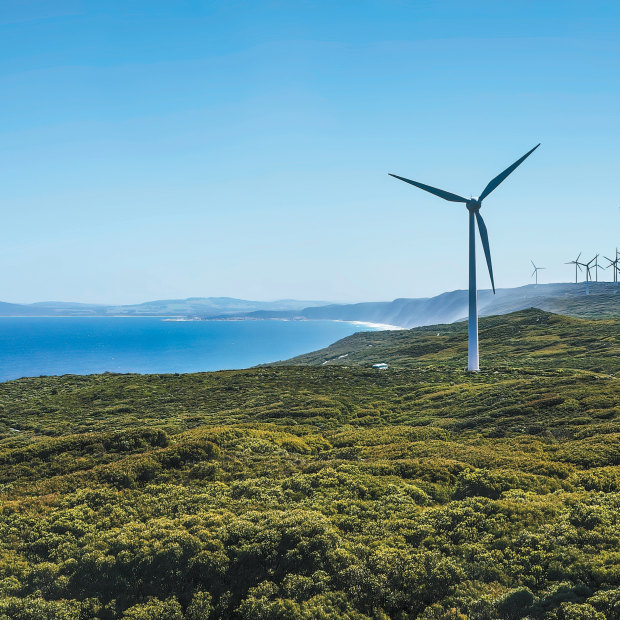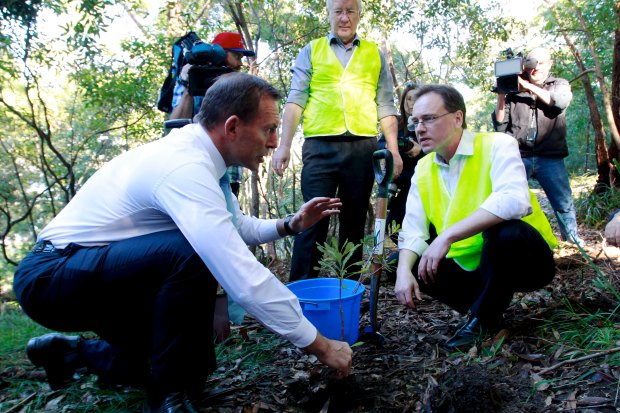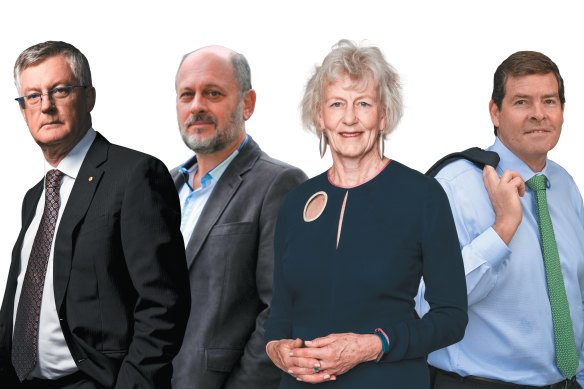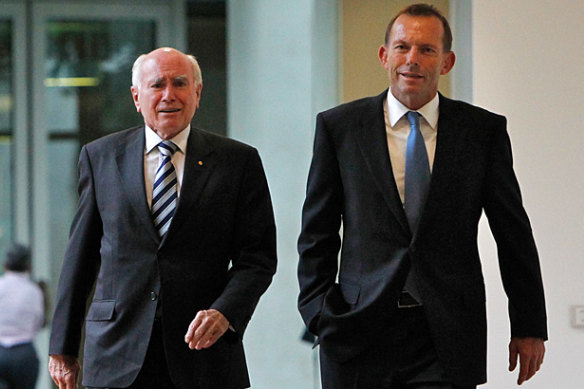This was published 4 years ago
'You bastards sacked me.' When the climate sceptics arrived
How did environmental issues become so politicised? The people purge early in the Abbott government – beginning in 2013 with the "night of the short knives" – gives some clues.
By Marian Wilkinson

When Tony Abbott became prime minister, a raft of legislation was introduced to shut down everything from the emissions trading scheme, the CEFC and the Climate Change Authority.Credit: Getty Images
On the first day of the new Abbott government, Australia’s climate scientists got a pretty clear message. It was September 18, 2013, and within 24 hours of the swearing-in ceremony at Government House in Yarralumla, the new environment minister, Greg Hunt, had called the head of the Climate Commission and sacked him.
“It was a short and courteous conversation,” Dr Tim Flannery recalls. “I’m pretty sure that cabinet hadn’t been convened when they did it. My very strong recollection is that it was their very first act in government.”
Flannery’s colleague on the commission, Professor Will Steffen from the Australian National University’s Climate Change Institute, was also sacked, along with all the other commission members. “I think we were the first definitive action of the Abbott government,” Steffen recalls. “They got rid of us and you could probably measure it in hours rather than days.”
What surprised the scientists most was not their hasty sacking but how quickly the government obliterated their work. “The website that we’d spent a lot of time building was taken down with absolutely no justification as far as I could see,” says Flannery, the one-time principal research scientist at the Australian Museum and internationally renowned scientific author. “It was giving basic information that was being used by many, many people – teachers and others – just to gain a better understanding of what climate science was actually about.”
The Climate Commission had been set up in 2011 by Julia Gillard’s Labor government as an independent source of information for the public to understand climate change and its impacts on Australia. But the commission and its members had been pilloried as “alarmist” by sceptical columnists in the Murdoch media and by radio shock jocks from the beginning. Flannery was expecting the commission to be disbanded, but the decision to kill its website hurt.
“I was almost proud to be sacked – for the first time in my life – from that post by Greg Hunt.”
Other commissioners – Professor Lesley Hughes, a Macquarie University biologist who worked with the United Nations’ Intergovernmental Panel on Climate Change (IPCC); Gerry Hueston, a former Australasian president of BP; and Roger Beale, the former head of the Department of the Environment during the Howard years – were all sacked by letter. Beale would wear the sacking as a badge of honour. “I was almost proud to be sacked – for the first time in my life – from that post by Greg Hunt,” he told me later.
Despite the attempt to erase their work from history, a group of the commissioners were determined to push on with their work. Within days of their sacking, they launched a publicly funded website under a new name, the Climate Council, and kept pumping out reports on climate science for the public to read. (It’s still active.)
Hunt argued that shutting down the Climate Commission was just part of the government’s plans to “avoid duplication of services” with the federal environment department. But Hunt, like everyone in the Abbott government from senior cabinet members down, knew the prime minister was a climate sceptic who questioned a lot of what the commission had reported. Abbott had made it clear over his years in opposition that he was dubious about mainstream climate science, opposed putting a price on Australia’s carbon emissions, and was hostile to renewable energy targets.

As environment minister, Greg Hunt (right) persuaded Tony Abbott not to oppose climate science publicly.Credit: Edwina Pickles
“I think that the proposition that climate is changing drastically, that man-made carbon dioxide emissions are the cause, and that therefore we must drastically reduce, almost at any cost, our carbon dioxide emissions – I think that proposition is not well-founded,” Abbott told me, echoing similar remarks he’d made to the ABC’s Four Corners program while in opposition.
Hunt liked to distance himself from Abbott on climate change by professing his own belief in the science. As environment minister, he struck an agreement with Abbott that the new government would not challenge climate science publicly. Abbott largely abided by this. Nevertheless Hunt worked hard on Abbott’s strategy to dismantle or review almost every major climate change policy put in place by Labor. That meant a purge. Unknown to Flannery and his colleagues, other sackings were already taking place. Hunt was not the only executioner; other senior ministers had to take up the axe as well.
The Saturday after Abbott’s election, Treasury secretary Martin Parkinson was pushing his shopping trolley through Coles in the upmarket Canberra suburb of Manuka when his mobile rang. On the line was Australia’s most senior bureaucrat, Ian Watt, head of the Department of Prime Minister and Cabinet. He told Parkinson to come to his office that afternoon before abruptly hanging up.
“No pleasantries, no nothing,” Parkinson recalls. His wife Heather Smith, also a senior public servant, was in the shopping aisle with him. “I think this is going to end badly,” he told her.
More than any other public servant in Canberra, Parkinson had a long history with climate change policy. A big-thinking economist with a policy brain to match, Parkinson had worked for the three previous administrations – John Howard’s Coalition government, and Kevin Rudd’s and Gillard’s Labor governments – on schemes to put a price on carbon emissions.
Until now, no one in the Abbott government had suggested Parkinson’s past would be a problem. After all, no incoming government had ever removed a Treasury secretary as far as anyone could remember. Since the election a week earlier, Parkinson had been talking with the new treasurer, Joe Hockey. He even got a call from the ebullient Hockey on the Friday night. “Great first week – really think we’re going to work well together,” Hockey told him.
He asked the Treasury secretary how his weekend went. “Shithouse,” Parkinson replied. “You bastards sacked me.”
But when Parkinson arrived at Ian Watt’s office that Saturday afternoon, he found Watt waiting anxiously with the Public Service commissioner, Steve Sedgwick. Watt couldn’t look his old colleague in the face. Instead he read out some legal words saying, effectively, the Abbott government didn’t have confidence in Parkinson’s ability to run the Treasury.
Oddly, they then asked Parkinson to stay on to help sort out Abbott’s promised Commission of Audit on government spending and deliver the first budget. If Parkinson was willing to do that, they might find him an overseas posting at the International Monetary Fund.
The Treasury secretary was not impressed. “I looked at Ian and I said, ‘I’m not going anywhere. If they want to sack me, they can sack me.’ ” After some difficult words back and forth, it was understood Parkinson would stay on for the budget. The two bureaucrats then gave him a hug before he left. Parkinson was totally stunned.
Parkinson heard nothing from his minister, Joe Hockey. So on Monday, he rang Hockey’s chief of staff, Grant Lovett. It was soon clear that Lovett was not in the loop: he asked the Treasury secretary how his weekend went. “Shithouse,” Parkinson replied. “You bastards sacked me.” A few minutes later Hockey was on the line. “He had no idea this was going to happen,” Parkinson recalls. “He was clearly upset. In fact it was a combination of upset and furious. And he went in to bat for me.”
Abbott hadn’t told Hockey he was purging his most senior, experienced public servant but Hockey bowed to Abbott and sucked it up. The purge that targeted Parkinson became known in Canberra as “the night of the short knives”.
“People were sent hell, west and crooked,” says Allan Behm, the former chief of staff for Labor’s climate change minister Greg Combet. Behm had served for years as a senior defence bureaucrat. “I couldn’t find any work. Nobody would touch us,” he tells me.
Abbott was just getting started. He was determined to completely overhaul Australia’s climate change policy. He had already put the wheels in motion more than a month before the election. While still opposition leader, a confident Abbott had written to Watt to tell him the bureaucrats should begin drafting laws to repeal Julia Gillard’s Clean Energy Act as soon as the election was over. The ground-breaking act passed in 2011 had put a price on carbon emissions.
The same day he wrote to Watt, Abbott had sent a warning letter to the chair of the Clean Energy Finance Corporation (CEFC), businesswoman Jillian Broadbent.
“Knock your socks off and tell me I shouldn’t be pursuing my job whilst you’re not my minister.”
The CEFC, set up by the Gillard government, was designed to drive investment in clean energy. During the caretaker government period before the election, Abbott wanted Broadbent to make sure it “immediately ceases to assess or make any further approvals or payments”.
Hunt and then shadow finance minister Andrew Robb also wrote to the CEFC’s board members before the election with the same message: we’re going to disband you, so don’t enter into any new contracts.
But when one opposition frontbencher contacted Oliver Yates, the corporation’s feisty chief executive, appointed by the Gillard government, Yates told him to back off. “I said, ‘I don’t know exactly what the law is here but knock your socks off and tell me I shouldn’t be pursuing my job whilst you’re not my minister,’ ” Yates recalled telling him. “As soon as you are my minister, as I understand it, you can’t ask me not to pursue my obligations. Under my role as a statutory officer, my power comes from Parliament.”
Yates was absolutely right. The former Macquarie executive was lacking in some of the social niceties, but he knew how to read legal advice. Neither Hunt nor Hockey nor Abbott had the power to shut down the CEFC until they got a new law through Parliament, and that included the Senate.
Broadbent quickly realised at their first meeting that neither Hockey nor Cormann had a clue what the corporation did.
Despite this, straight after the election, Yates and Broadbent were summoned to a meeting with Hockey and the new finance minister, Mathias Cormann. Broadbent was deeply worried that the government, in its haste to kill off the corporation, would have a fire sale of all its investments in renewable energy projects. That would trash the value of the assets, something she really wanted to avoid.
Broadbent told both ministers the corporation’s investments were good and they would be able to sell them at 100 per cent of their value if that became necessary. Hockey was genial, but Broadbent quickly realised at their first meeting that neither he nor Cormann had a clue what the corporation did – that it was working in syndicates with big private investors to get large renewable projects built.
“It was part of their platform to unwind it, but they had little understanding of what we were doing. So in the end, the treasurer said, ‘What exactly do you do there, Jillian?’ ” she recalls.
To the Liberal ministers, the CEFC was just seen dismissively as “Bob Brown’s Bank”, a Labor-Greens scheme that had to go. “They didn’t want to really know about the CEFC,” recalls Broadbent, who previously worked for Bankers Trust and has sat on numerous boards including the Reserve Bank of Australia and Woolworths. “It wasn’t their idea and their policy platform was to close it, and they almost convinced themselves it was a great big ‘Green Bank’, or whatever jargon they used to describe it.”

Under fire (from left): Martin Parkinson, Tim Flannery, Jillian Broadbent and Oliver Yates.Credit: Dominic Lorrimer; Wayne Taylor; James Brickwood; Eddie Jim
Despite Broadbent’s warning to the ministers, Treasury officials soon followed up and advised her they would be appointing one of the top accounting firms to liquidate the corporation’s assets. But Yates had already been talking to the new Senate crossbenchers and was convinced Abbott and Hockey were going to be blocked in the Senate. “The numbers were always in our favour,” says Yates, “so it didn’t worry me particularly from day one that they would ever get it through the Senate.”
Abbott was determined to press ahead, seeing it all as part of his mandate. When the new Parliament sat, Hockey and Hunt introduced a raft of legislation to shut down everything from the emissions trading scheme, the CEFC and another key body, the Climate Change Authority, that advised the government on Australia’s emissions targets. Abbott was doubling down on his divisive strategy that had been so successful in opposition. And a cheer squad of powerful supporters were on hand to encourage him on his course.
That November, the old sceptic warhorse and influential Liberal Party businessman, Hugh Morgan, launched a timely attack on the world’s climate scientists working with the IPCC. The attack came shortly before the Abbott government introduced the legislation to kill off Labor’s climate policies. Morgan, the former chief executive of Western Mining Corporation, compared the climate scientists to Chicken Little, alarmists who kept warning the sky would fall in.
Not long before this, the Liberal Party’s donor cash cow, the Cormack Foundation, which Morgan chaired, had stumped up another $300,000 for the Institute of Public Affairs. The conservative think tank’s latest publication, Climate Change: The Facts 2014, was soon in the works with essays from Australia’s best known climate sceptics, News Corp’s Andrew Bolt and former James Cook University professor Bob Carter, along with their international cohorts by now so familiar here: MIT’s Professor Richard Lindzen, Dr Pat Michaels from the US Cato Institute – a think tank co-founded by American billionaire Charles Koch – and the former UK chancellor Nigel Lawson.
At the same time as Morgan’s attack, Lawson’s UK think tank, The Global Warming Policy Foundation, welcomed Abbott’s old mentor, John Howard, to deliver its annual lecture in London. The former Liberal prime minister used the opportunity to enthusiastically back Abbott’s plan to dismantle Labor’s climate policies in a speech he called “One Religion is Enough”.
Howard confidently predicted to the London crowd that serious concerns about climate change were on the decline: “The high level of public support for overzealous action on global warming has now passed. My suspicion is that most people in Australia, on this issue, have settled into a state of sustained agnosticism.”

John Howard and Tony Abbott: the two shared similar views on the Renewable Energy Target. Credit: Andrew Meares
Howard’s old antagonism to the Renewable Energy Target (RET) was still festering. Despite Howard introducing Australia’s first modest renewable energy target in 1997, he became hostile to it after Labor increased the target to around 20 per cent of electricity by 2020. Howard told the UK think tank that in Australia there was “a growing consciousness that large subsidies are being paid to the production of renewable energy, and that this is having an increasingly heavy effect on low-income earners”.
Howard’s view was shared by Abbott. The RET was another climate policy the new prime minister wanted dumped. One very vocal opponent of renewable energy already had Abbott’s ear – Maurice Newman, the man he had hand-picked as his new chair of the Prime Minister’s Business Advisory Council. A prominent climate change denier, Newman was well known for his ferocious opposition to wind farms.
Newman was a well-connected conservative networker, a former chairman of the ABC and of the Australian Stock Exchange. He applauded Abbott’s hostility to the RET, blaming it, with Labor’s emissions trading scheme, for destroying Australia’s industrial competitiveness. Newman was furious that Australia, in his view, had become “hostage to climate-change madness”.
“The scientific delusion, the religion behind the climate crusade, is crumbling,” Newman told The Australian shortly after his appointment by Abbott. “Global temperatures have gone nowhere for 17 years. Now, credible German scientists claim that ‘the global temperature will drop until 2100 to a value corresponding to the little ice age of 1870.’ ”
When the Warburton review came down, it recommended winding back the RET. But renewable energy was popular with voters.
The ice age prediction seemed unlikely to pan out. But one thing Newman could bet on was an inquiry into Australia’s RET, a move Abbott flagged before the election. The government picked another high-profile climate-sceptic businessman for the job, Dick Warburton, a former chairman of the oil company Caltex Australia. Warburton defended his appointment, saying, “I am not a denier of climate change. I am a sceptic that man-made carbon dioxide is creating global warming.”
The Warburton review was a challenge for Hunt, who’d been an RET supporter. When Hunt, along with Industry and Science Minister Ian Macfarlane, announced the review, they both knew it would be politically fraught. Abbott had gone to the election promising to keep the RET. Now he wanted to backtrack on that, and the review could be a way to do it.
“I would’ve liked to have drastically reduced or abolished the Renewable Energy Target in early 2015,” Abbott recalls. “As we know, the RET has done untold damage to our power system.”
News of Warburton’s appointment was a blow to the renewables industry, already reeling from the U-turns in Canberra’s climate policy. Investment was dropping like a stone. Over at the CEFC, Oliver Yates watched it collapse around this time. “It absolutely froze it, it chilled it,” says Yates.
Abbott would look back at this collapse with pride. “Good,” he said to me later. “I mean, subsidised renewable energy has done so much damage. It’s driven prices up, it’s driven reliability down. I mean all these rent-seekers love it because it’s a licence to print money. But it’s printing money at the expense of consumers and the jobs of people in heavy industry.”
Not surprisingly, when the Warburton review came down in August 2014, it recommended winding back the RET. But renewable energy was incredibly popular with voters, and Warburton’s report was attacked by all sides of politics, including by some Coalition members and senators in regional Australia.
Hunt and Macfarlane finally managed to persuade Abbott to compromise with Labor, modestly cutting the 2020 target. But the compromise infuriated the RET’s opponents, including Newman, the prime minister’s senior business adviser. The day the compromise deal was announced Newman managed to exact some revenge. He wrote one of his inflammatory columns in The Australian, in which he virtually accused the UN of a global conspiracy for wanting to reduce greenhouse gas emissions.
“It’s a well-kept secret, but 95 per cent of the climate models we are told prove the link between human C0₂ emissions and catastrophic global warming have been found, after nearly two decades of temperature stasis, to be in error,” Newman wrote. “Why then, with such little evidence, does the UN insist the world spend hundreds of billions of dollars a year on futile climate change policies?” The reason, Newman argued, was simple: “This is not about facts or logic. It’s about a new world order under the control of the UN.”
By the end of Abbott’s first year in office, the PM had made it clear he didn’t believe most climate scientists, even those who worked for his government. But while his climate scepticism could shape policy in Canberra, it would soon put him in conflict with the most powerful leader in the world, US president Barack Obama.
This is an edited extract from Marian Wilkinson’s The Carbon Club (Allen & Unwin, $33), out Monday.
To read more from Good Weekend magazine, visit our page at The Sydney Morning Herald, The Age and Brisbane Times.